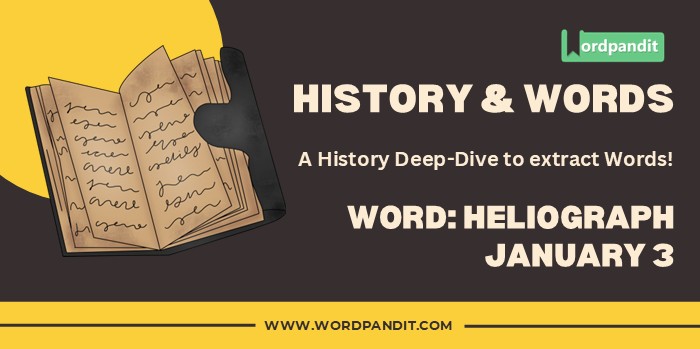History & Words: ‘Heliograph’ (January 3)
Welcome to ‘History & Words.’ 🌟 I’m Prashant, founder of Wordpandit and the Learning Inc. Network. This series combines my passion for language learning with historical context. Each entry explores a word’s significance on a specific date, enhancing vocabulary while deepening understanding of history. Join me in this journey of words through time.
📚 Table of Contents
🔍 Word of the Day: Heliograph
Pronunciation: /ˈhiːliəʊˌɡrɑːf/ (hee-lee-oh-GRAF)
🌍 Introduction
On January 3, 1879, the British Army achieved a significant milestone in military communications when they successfully deployed the heliograph during the Anglo-Zulu War. This innovative device, which used mirrors to flash sunlight signals across vast distances, marked a revolutionary advancement in long-distance communication in sunny conditions.
The heliograph represents an ingenious intersection of simple physics and practical necessity, demonstrating humanity’s creativity in overcoming communication barriers before the advent of electronic telecommunications. Its deployment not only transformed military communications but also found civilian applications in surveying and emergency signaling.
This device’s significance extends beyond its technical innovation, symbolizing an era when armies and governments were actively seeking new ways to coordinate actions across the expanding territories under their control. The heliograph’s ability to transmit messages quickly over long distances without physical infrastructure made it particularly valuable in colonial campaigns and frontier operations.
🌱 Etymology
The word “heliograph” combines two Greek elements: “helios” meaning “sun” and “graphein” meaning “to write.” This literal translation, “sun writing,” perfectly describes the device’s function of using sunlight to communicate messages. The term emerged in the mid-19th century as the technology was developed and refined.
📖 Key Vocabulary
- 🔑 Heliotrope: A surveying instrument similar to the heliograph, used to reflect sunlight over great distances to mark survey points
- 🔑 Morse Code: The system of dots and dashes used to encode messages transmitted by heliograph
- 🔑 Signal Corps: Military units specialized in communications, including heliographic signaling
- 🔑 Semaphore: A system of visual signaling using flags or arms, often used in conjunction with heliographic communication
🏛️ Historical Context
The development of long-distance communication has been a crucial factor in military success and civil administration throughout history. Before electronic communication, armies and governments relied on various visual and acoustic methods to transmit messages, from smoke signals to drum beats.
The invention of the heliograph in its modern form is credited to Sir Henry Christopher Mance, who developed it while serving in India in 1869. The British military quickly recognized its potential, particularly in colonial territories where traditional telegraph lines were vulnerable to sabotage or impractical to install.
The device proved especially valuable in arid regions with abundant sunlight, such as India, South Africa, and the American Southwest. The U.S. Army would later adopt the technology, using it extensively in campaigns against Native American tribes and in the Spanish-American War.
⏳ Timeline
- 1869: Sir Henry Christopher Mance develops the modern heliograph
- 1875: British Army begins testing heliographs in India
- 1877: First military trials in Afghanistan
- January 3, 1879: First successful military use in Anglo-Zulu War
- 1886: U.S. Army adopts heliograph for frontier communications
- 1890s: Peak of heliograph use in military operations
- 1940s: Last widespread military use during World War II
🌟 The Day’s Significance
January 3, 1879, marked the first successful military application of the heliograph by British forces during the Anglo-Zulu War. This success demonstrated the device’s potential for military communications in colonial territories where traditional telegraph lines were impractical or vulnerable.
The implementation of heliographic communication provided British forces with a significant tactical advantage. Messages could be transmitted over distances of up to 40 miles in good conditions, allowing for rapid coordination of military movements and improved situational awareness.
The success of the heliograph on this day led to its widespread adoption across the British Empire and influenced military communications strategies for decades to come. The device’s effectiveness in sunny colonial territories made it an essential tool in the expansion and administration of colonial powers.
🔮 Modern Usage and Reflection
While the military use of heliographs has long since been superseded by electronic communications, the principles behind the device continue to influence emergency signaling and solar applications. Modern survival kits often include signal mirrors based on similar principles, and the concept of using reflected sunlight has found applications in solar energy technology.
The heliograph serves as a reminder of human ingenuity in solving communication challenges and the importance of adapting technology to specific environmental conditions. Its success demonstrates how relatively simple technologies can have profound effects on military operations and civil administration.
🏛️ Legacy
The heliograph’s legacy lives on in modern emergency signaling devices and in the history of military communications. Its development represents a crucial step in the evolution of long-distance communication, bridging the gap between primitive visual signals and electronic telecommunications.
The principles of heliographic communication continue to influence modern solar technologies and optical communication systems, demonstrating how historical innovations can inspire contemporary solutions to similar challenges.
🔍 Comparative Analysis
While the heliograph was revolutionary in its time, its limitations in cloudy weather and at night highlight the continuous need for redundant communication systems. Modern military communications rely on multiple technologies to ensure reliable message transmission under all conditions, a principle first recognized during the heliograph era.
💬 Quote
“The heliograph has proved invaluable in maintaining communications across vast stretches of territory where the establishment of telegraph lines would be impracticable.” – General Nelson A. Miles, U.S. Army, 1886
💡 Did You Know?
🎓 Conclusion
The heliograph represents a fascinating chapter in the history of human communication, demonstrating how innovative solutions to military challenges can arise from simple principles of physics. Its successful deployment on January 3, 1879, marked a significant advancement in military communications and colonial administration, while its legacy continues to influence modern emergency signaling and solar technologies.
📚 Further Reading
- 📘 “The Heliograph: A Lost Art of Communication” by Lewis Coe
- 📗 “Military Communications: From Ancient Times to the 21st Century” by Christopher Sterling
- 📙 “Signal Success: A History of the Signal Corps” by Rebecca Robbins Raines












